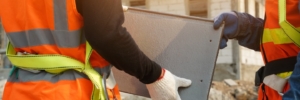5 Simple Safety Tips for Construction Sites
With construction ranking as one of the most dangerous professions, safety should rank high on the minds of those in the industry.
Many of the most important safety practices for construction workers come easily to those who have received a proper education on the subject, but for those who haven’t had that opportunity, here are 5 tips to keep construction sites as safe as possible.
-
Utilize a Safety Checklist
The first step in ensuring construction site safety is taking stock of all the components. This kind of checklist will draw attention to items of importance – from equipment and electrical elements, to hazard communication.
Knowing all of the components involved in a project allows workers to be conscious of how to work on the site, while keeping aware of any potential risks. A checklist helps to ensure a smooth and safe project goes underway every step of the way.
-
Follow a Lockout/Tagout System
Those who have worked in construction for any length of time are likely very familiar with lockout/tagout. This system requires that equipment or machinery be properly disabled while maintenance occurs.
Following this kind of procedure ensures workplace safety in a number of ways, particularly in terms of electrical work. It is vital as electrocution is a common culprit for construction injury and even death.
-
Check Scaffolding
Scaffolding is one of the most common hazards on construction sites, due largely to the fact it is so commonly used and it can so easily be installed or maintained improperly if workers are not properly trained.
Equipment can shift, crack or be altered in an unsafe way during use, resulting in compromised safety. Scaffolding should be regularly inspected for any components that may have been compromised during the course of the job.
-
Wearing Proper Personal Protective Equipment
This may seem like a no brainer, but many workers will skip on wearing proper personal protective equipment for the sake of comfort, convenience or a simple lack of time and this can be a dangerous game of cutting corners.
The hazards are different on every site, so discretion and wherewithal are necessary. The need for everything from safety glasses and steel-toed boots, to hard hats, should be respected and followed in order to ensure workers’ safety.
-
Only Operate Machinery if Properly Licensed
Most people who have spent a good portion of their careers in construction understand the importance of only operating equipment if they have received the proper training.
The issue with taking on a piece of machinery when not trained is that a worker can make a mistake without having any idea that they are even making it, resulting in disaster.
For more info about the construction safety training that Construction Safety Experts offer, check out our list of safety training and risk management services.
It is impossible to encompass every important safety consideration in a short space, so suffice it to say that proper education for all workers is the most effective precaution possible.
Let Construction Safety Experts help ensure that your workers receive the proper training, contact us today or call (866) 463-0669.





